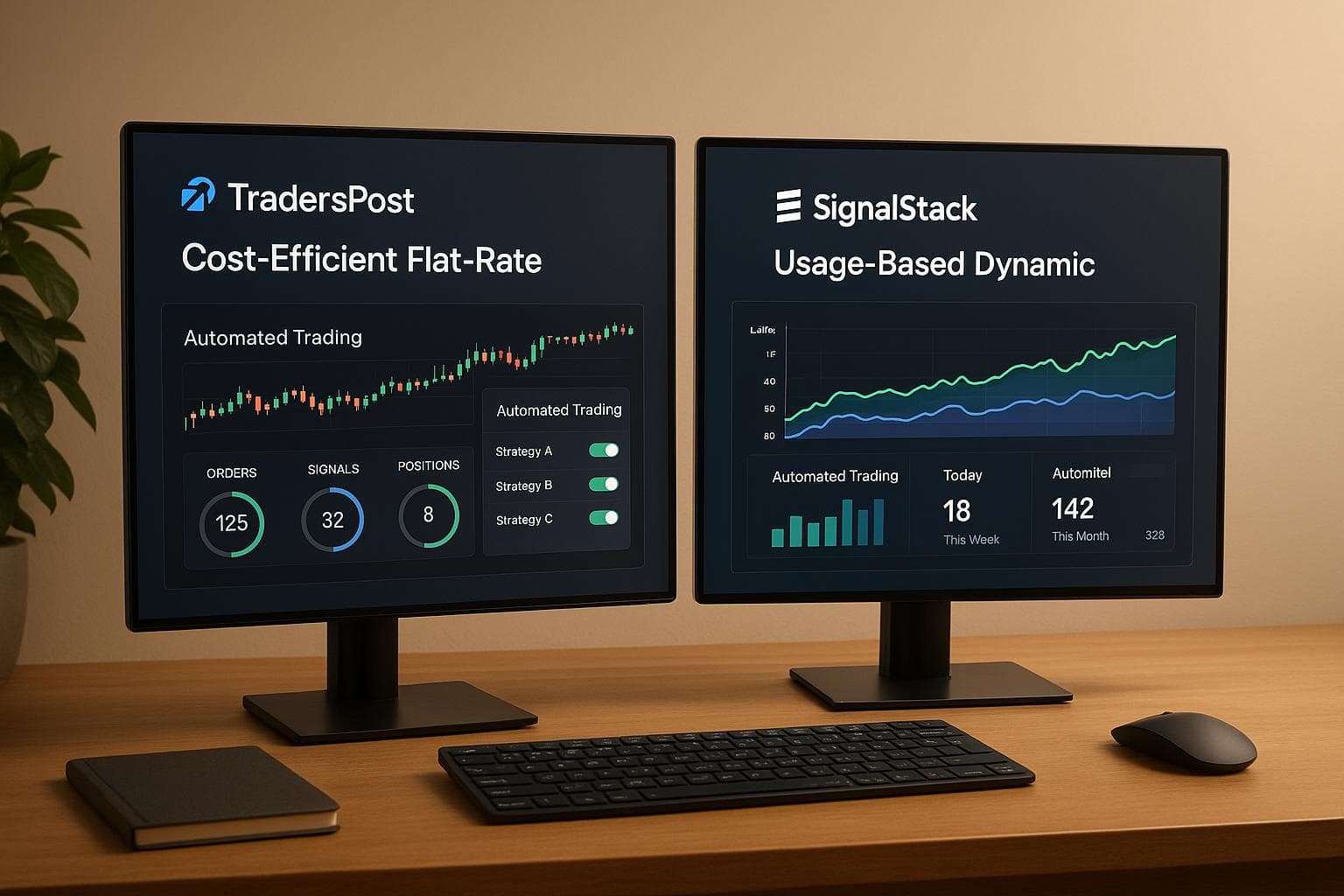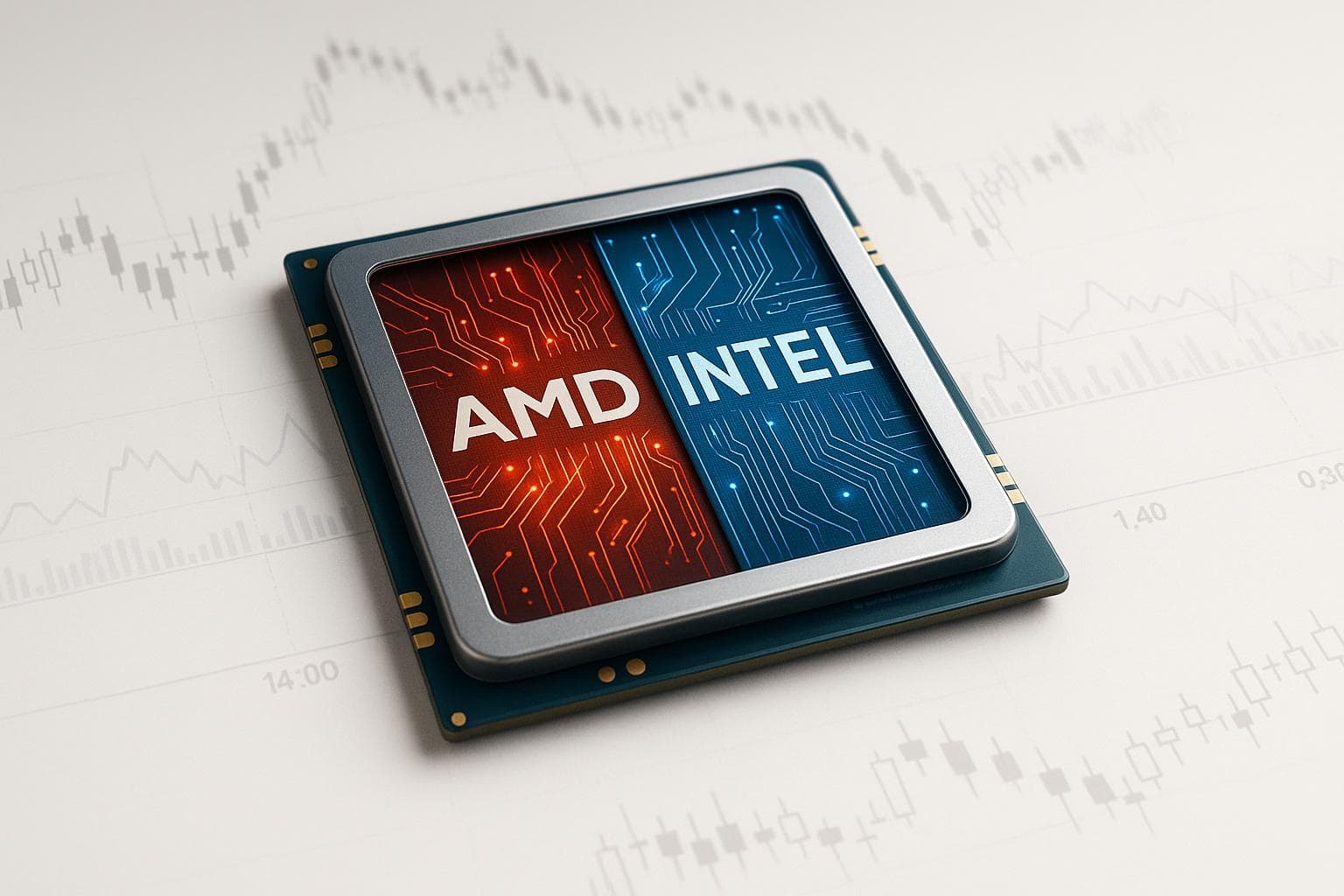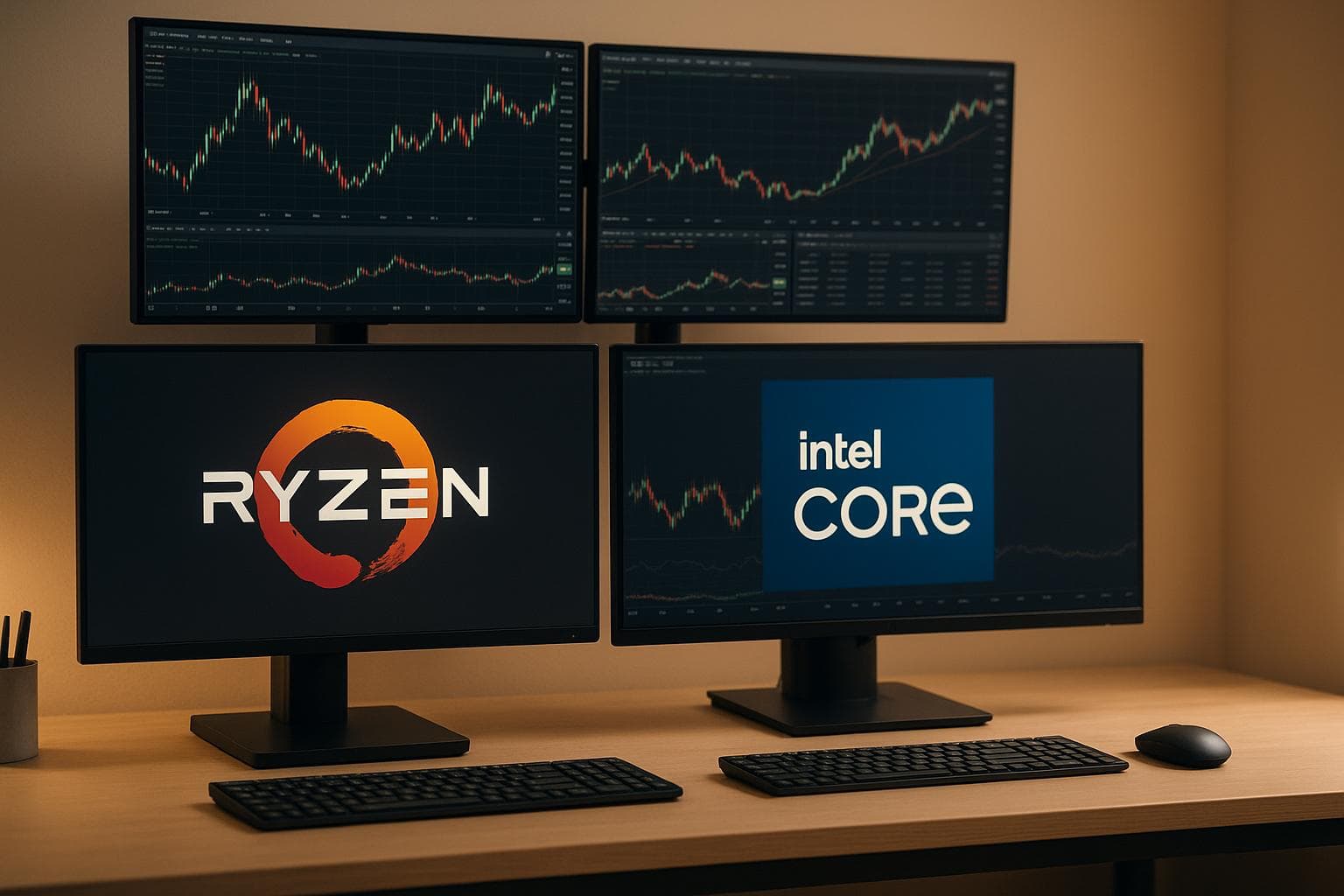Choosing the right broker is critical for day trading success in 2025. With fast execution speeds, advanced tools, and reliable platforms now essential, traders must align their broker choice with their trading style and hardware setup. Here’s a quick summary of the top brokers:
- Interactive Brokers (IBKR): Known for low-latency execution (75–130ms), direct market access, and advanced tools like Trader Workstation (TWS). Ideal for professional traders with multi-monitor setups and algorithmic trading needs. Offers competitive tiered pricing for high-volume trades.
- Webull: Commission-free trading with sleek charting tools and real-time data delivery. Best for retail traders but relies on payment for order flow (PFOF), which may affect execution quality.
- Charles Schwab (thinkorswim): Offers a robust platform with advanced charting, economic data integration, and fast execution (0.05 seconds). Great for intermediate traders seeking powerful yet approachable tools.
- Robinhood (Legend): Simplified, commission-free trading with basic tools. Suited for casual traders but lacks advanced order types and execution precision required for high-frequency trading.
Quick Comparison
| Broker | Best For | Execution Speed | Options Fees | Platform Highlights |
|---|---|---|---|---|
| Interactive Brokers | Advanced traders | 75–130ms | $0.15–$0.65/contract | Direct market access, customizable API |
| Webull | Retail traders | ~98.96% execution rate | $0 commission | Real-time data, 60+ indicators |
| Charles Schwab | Intermediate traders | 0.05 seconds | $0.65/contract | thinkorswim, detailed charting |
| Robinhood | Casual traders | PFOF-based | $0 commission | Basic tools, simple interface |
Key takeaway: Interactive Brokers leads for professional setups, while Schwab balances functionality and ease of use. Webull is cost-effective but may compromise on execution quality, and Robinhood is best for beginners. Choose based on your trading needs and hardware capabilities.
Ranking the FASTEST Online Trading Brokers for 2025
1. Interactive Brokers
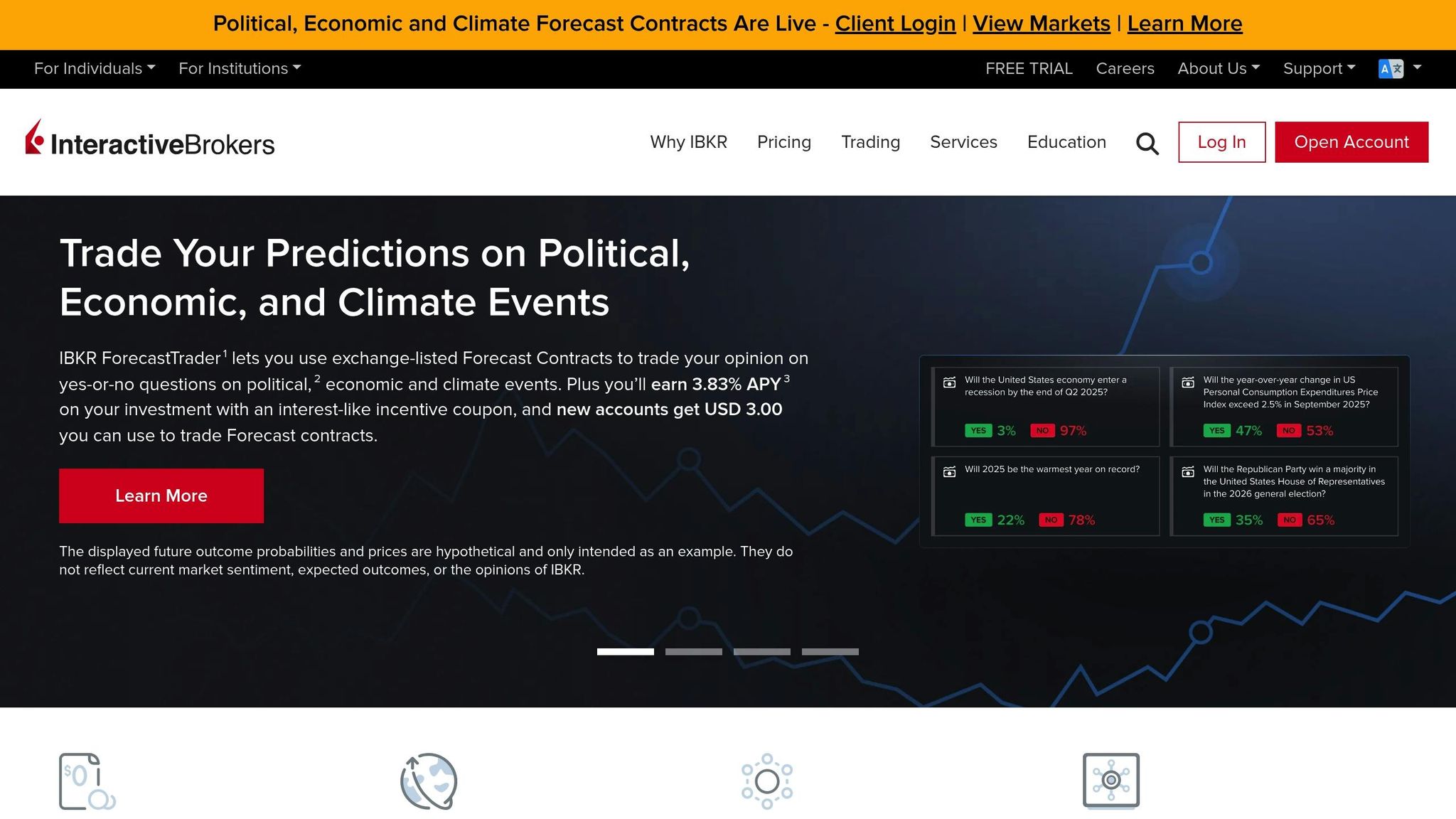
Interactive Brokers (IBKR) is a powerhouse in the trading world, offering institutional-grade execution and access to global markets. With over 2.39 million trades processed daily across 160 markets and 28 currencies, IBKR has earned its reputation as a go-to platform for professional traders who demand top-tier infrastructure.
Low-latency execution
For traders where speed is everything, IBKR delivers with its low-latency execution capabilities. By leveraging direct market access (DMA) and smart routing technology, the platform ensures order acknowledgment latency falls between 75–130 milliseconds. For those with advanced setups, IBKR’s API supports complex order types and execution algorithms, offering direct connections to the market. Traders can also access live Level 2 market depth and multiple routing options to fine-tune their order quality. Professionals looking for an edge can take advantage of colocation services or VPS hosting near major exchanges. For instance, QuantVPS provides hosting specifically optimized for IBKR, boasting a lightning-fast 0.52ms latency to the CME along with 24/7 technical support.
Fee structure
IBKR offers two pricing models to cater to different types of traders. IBKR Lite provides commission-free trading for U.S. stocks and ETFs but operates on a payment-for-order-flow model. IBKR Pro, on the other hand, uses a tiered pricing structure starting at $0.0005 per share with a $1 minimum, making it ideal for high-volume traders. Options trading costs range from $0.15 to $0.65 per contract, while futures contracts are priced between $0.25 and $0.85 per contract based on trading volume. Spot currency trades are charged at 0.08 to 0.20 basis points of the trade value. Margin rates are also competitive, starting at the benchmark rate plus 0.5% for Pro users, with even lower rates available for balances exceeding $1 million.
Charting and analytical tools
IBKR’s Trader Workstation (TWS) is packed with features for in-depth technical analysis. It offers advanced charting tools, a wide array of indicators, and multi-chart views for tracking various symbols and timeframes simultaneously. Users can apply indicators through the "fx Indicators" button, utilize drawing tools like Fibonacci retracements and trend lines, and monitor markets in multi-chart mode. However, some professional traders find TWS a bit cumbersome for fast-paced scalping and prefer to use it as a backend broker while integrating it with lighter, faster front-end platforms.
Platform compatibility
The flexibility of IBKR’s platform makes it a favorite for seasoned traders. Its API supports real-time and historical market data, portfolio margining, and over 100 order types and algorithms, making it an excellent choice for algorithmic trading. For those using multi-monitor setups, IBKR’s customizable Mosaic workspace and Desktop platform allow for tailored layouts, streamlining both analysis and execution. While the API does require programming expertise, it’s a powerful tool for developing and testing custom trading strategies, with extensive documentation and sample code to guide users.
2. Webull
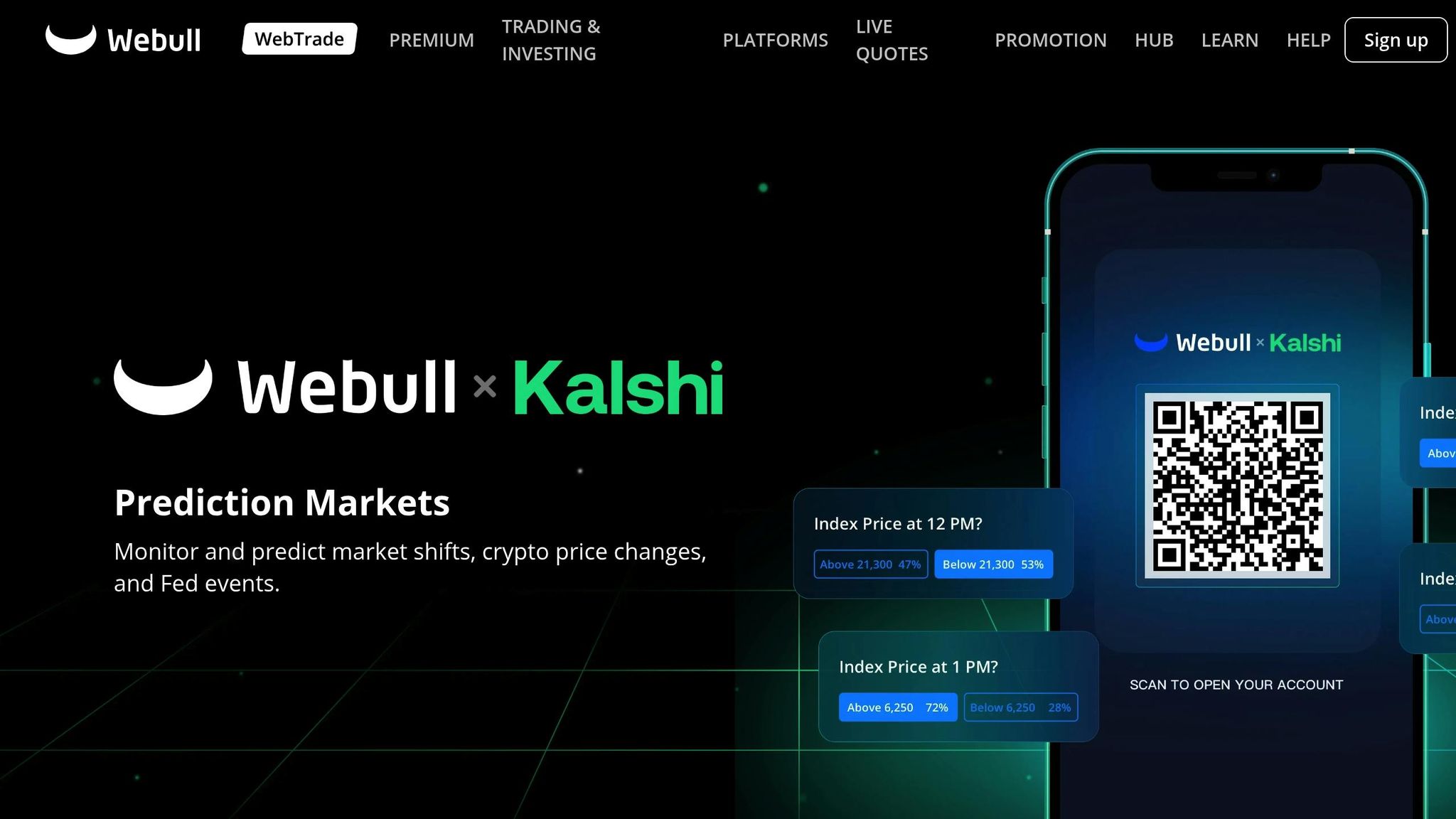
Webull combines commission-free trading with advanced analytical tools, making it a popular choice for traders. The platform is part of China-based Fumi Technology, with its technology team operating out of Hunan, China, while customer-facing and brokerage operations are based in New York City. This setup provides a solid foundation for delivering fast execution, competitive fees, and powerful analysis tools.
Low-Latency Execution
Webull’s technical infrastructure is designed for speed and reliability, utilizing HTTP, GRPC, and MQTT protocols. MQTT, in particular, enables the high-frequency, low-latency delivery of real-time market data. The platform boasts a 98.96% execution quality rate for trades of up to 99 shares, surpassing the industry average of 96.95% as of October 16, 2024. This performance is especially appealing to traders relying on optimized hardware for quick decision-making.
Fee Structure
Webull offers commission-free trading for stocks, ETFs, and equity options. However, standard regulatory fees still apply, including a charge of $0.0000278 per dollar (minimum $0.01) and a FINRA fee of $0.000166 per dollar (minimum $0.01, capped at $8.30 per trade) for stocks and ETFs. Options trading is also commission-free for equity options, while non-equity index options incur a fee of $0.55 per contract. Futures contracts are priced competitively, with rates of $1.25 for regular futures, $0.70 for mini futures, and $0.25 for micro futures. Margin rates are tiered, starting at 8.99% for balances under $25,000 and dropping to 4.99% for balances exceeding $3,000,000. While Webull’s zero-commission structure is attractive, the platform employs payment for order flow (PFOF), which could influence execution prices.
Charting and Analytical Tools
Webull excels in charting, offering over 60 technical indicators and 20 drawing tools. Its customizable layouts allow users to analyze data with time intervals as precise as one tick. The platform also provides Level 2 market data, which includes full order book depth and National Best Bid and Offer information, giving traders deeper insights into market activity. Jessica Inskip, Director of Investor Research at StockBrokers.com, praised the platform’s capabilities:
"Webull’s charting is responsive and well-equipped, featuring multiple chart types, drawing tools, and 59 technical indicators. I was able to manage orders directly from the chart, and hotkeys with grid layouts made it easy to compare multiple charts."
The platform supports eight different line styles, including traditional candlestick and Heikin Ashi charts. For those looking to test strategies, a paper trading simulator with real-time data and comprehensive indicator studies is available.
Platform Compatibility
Webull’s interface is clean and highly customizable, featuring hotkeys and grid views that are perfect for multi-monitor setups favored by active traders. The mobile app mirrors the desktop version’s functionality, enabling users to manage trades seamlessly while on the move. The platform also supports recurring investments for individual stocks and ETFs, making it easier to implement a dollar-cost averaging strategy. However, its research tools cater more to technical analysis than to in-depth fundamental research. It’s worth noting that traders subject to the Pattern Day Trading rule must maintain a minimum of $25,000 in a margin account to execute more than three day trades within a rolling five-business-day period.
3. Charles Schwab

Charles Schwab has earned recognition from Investor’s Business Daily for its Trade Execution Speed and Price in 2024. This achievement stems from its cutting-edge order routing systems and the robust thinkorswim platform. Let’s dive into how Schwab’s execution systems cater to the fast-paced world of day trading.
Low-Latency Execution
At the heart of Schwab’s trading infrastructure is the Schwab Order Execution Advantage system, designed to monitor and optimize order execution in real time. By analyzing performance across various market venues, this system ensures orders are routed to venues offering the best outcomes. Thanks to this approach, Schwab boasts an average execution speed of just 0.05 seconds. In Q1 2025, Schwab clients collectively benefited from $542 million in price improvement on exchange-listed equity orders, with 97% of orders receiving such improvements. Larger orders often achieved fills at volumes up to seven times the displayed quote.
To maintain accuracy and transparency, Schwab employs S3 Matching Technologies, an independent third-party service, to verify client executions. This added layer of oversight underscores Schwab’s commitment to the precision that day traders demand.
Fee Structure
Schwab’s pricing model is straightforward: commission-free stock and ETF trades, with options trades costing $0.65 per contract and no base commission. There are no account minimums or hidden fees, which has earned Schwab glowing reviews, including a 5-star Bankrate score and a 5.0 rating from Forbes Advisor. This clear and upfront fee structure complements Schwab’s suite of analytical tools.
Charting and Analytical Tools
Schwab’s thinkorswim platform is a powerhouse for technical analysis, offering tools like advanced indicators, drawing capabilities, and customizable chart layouts tailored for multi-monitor setups. Traders can leverage features such as trendlines, moving averages, and volume analysis. The Studies menu provides access to indicators like the Simple Moving Average (SMA) and VolumeAvg, while built-in drawing tools simplify marking support and resistance levels.
For active traders, the Active Trader tab delivers live buying and selling activity, helping pinpoint trade timing. Additionally, the platform integrates live streaming via the Schwab Network, real-time economic updates, and customizable price alerts, putting all critical information at users’ fingertips. Traders can also refine strategies with the paperMoney® feature, a simulation tool that uses real market data to test approaches without risking actual funds.
"Between the powerful tools, complex order tickets, and real-time insights, Schwab’s thinkorswim platform is a go-to for serious active traders and is, in my experience, one of the best on the market." – Jessica Inskip, Director of Investor Research at StockBrokers.com
Platform Compatibility
Schwab’s thinkorswim platform caters to professional day traders with its availability across desktop, mobile, and web environments. It supports advanced order types, such as conditional and bracket orders, which allow traders to set take-profit and stop-loss levels directly within the charting interface. The platform also provides access to a wide range of products, including stocks, ETFs, options, futures, and forex, enabling seamless trading across multiple asset classes.
sbb-itb-24dd98f
4. Robinhood
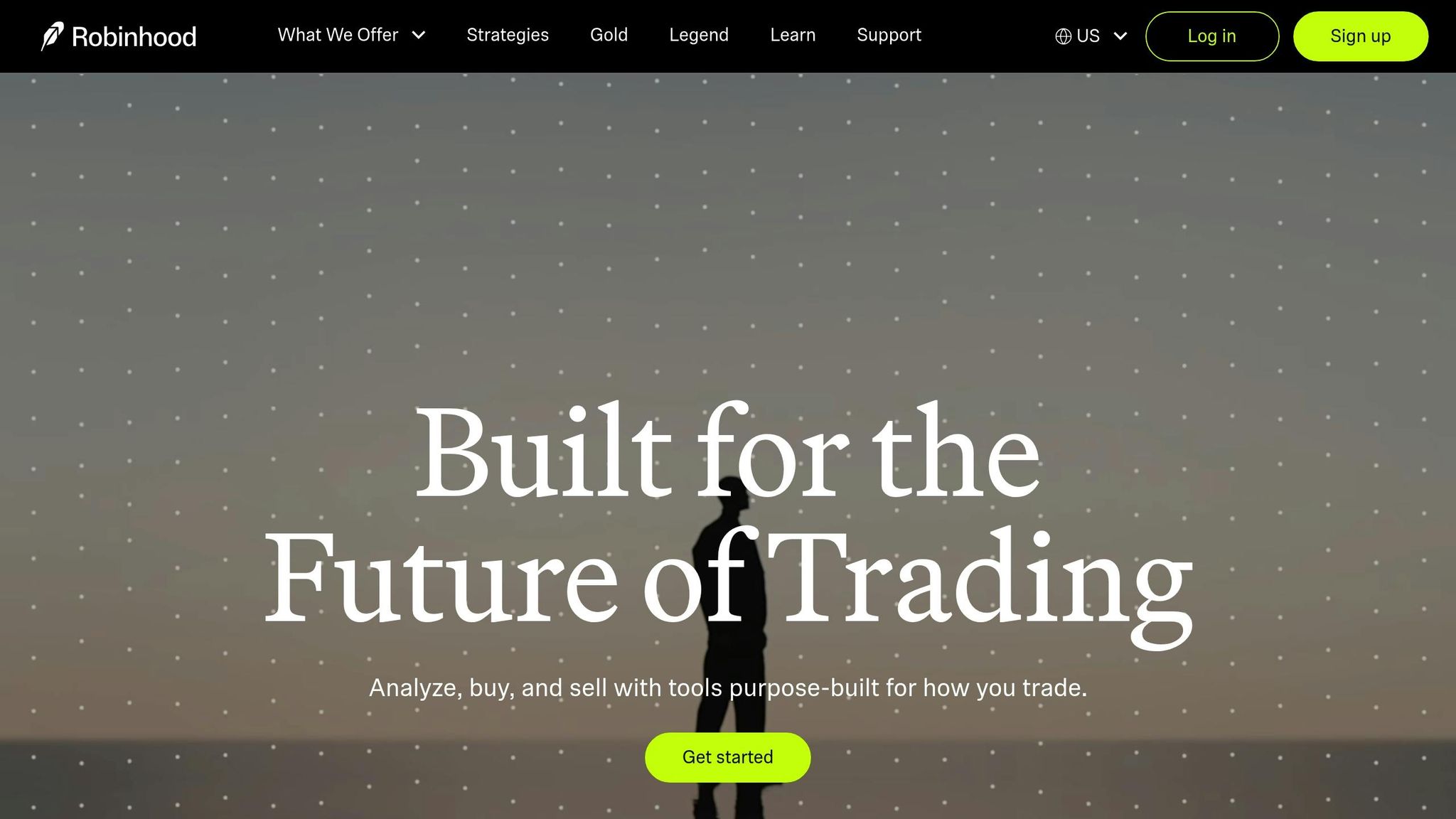
Robinhood has gained attention for its commission-free trading model and the introduction of its Legend platform, which includes advanced trading tools. However, day traders need to consider whether Robinhood’s execution quality and features meet the demands of high-frequency trading.
Low-Latency Execution
Robinhood’s order execution relies on payment for order flow (PFOF) agreements with market makers. Through this system, orders are routed to market makers who demonstrate strong execution standards. According to Robinhood, the platform achieves a reported net price improvement of $2.43 per 100 shares, with 96.25% of trades executed at or better than the National Best Bid and Offer (NBBO).
While this system is designed to enhance execution efficiency, it does not offer the direct market access or customizable smart routing algorithms that professional day traders often require. These features are essential for traders who depend on precision and flexibility in high-frequency trading environments.
Fee Structure
Robinhood provides commission-free trading for stocks, ETFs, options, and cryptocurrencies. However, some additional fees apply:
- Trading Activity Fee (TAF): $0.000166 per share for equity sells and $0.00279 per contract for options sells, capped at $8.30 per trade.
- SEC Fee: $27.80 per $1 million of principal for sell orders, though Robinhood waives this fee for sales with a notional value of $500 or less.
- Robinhood Gold: A subscription offering premium features like margin trading for a monthly fee.
- Account Transfers: A $100 fee applies for transferring accounts to another broker.
Charting and Analytical Tools
The Legend platform offers a customizable web interface equipped with over 50 technical indicators and supports multi-monitor setups with real-time data updates that refresh at sub-second intervals. However, experienced traders may find the platform’s features lacking in some areas. For instance, advanced order types like bracket orders and hotkeys are missing, as are more comprehensive market data tools. Additionally, its research capabilities are basic, with no fundamental analysis tools or economic calendar to track key market events.
Platform Compatibility
Robinhood Legend operates as a web-based platform, making it compatible across devices without requiring software downloads. It includes basic discovery tools such as "Top Movers" and "Popular Stocks" lists, along with filters for market cap and price. However, it does not offer in-depth screening options for fundamentals or technical indicators.
"Despite the limitations, I’m excited about Legend’s potential. By building an innovative trading experience from the ground up, Robinhood has created something that feels fresh and original. In my opinion, this new web platform is on the path to evolving into something truly legendary."
For traders using optimized hardware and multi-monitor setups, the platform’s execution precision and tool sophistication are crucial factors to evaluate. While Robinhood serves as a cost-effective and user-friendly option, its current capabilities may fall short for professionals engaged in high-frequency trading. This analysis sets the stage for a closer comparison of broker strengths and weaknesses.
Broker Comparison: Pros and Cons
When it comes to day trading, picking the right broker is all about finding the perfect balance between execution quality, costs, and platform features that align with your trading style. Each broker has its own set of advantages and drawbacks, and these can have a big impact on your trading results.
Execution Quality and Platform Features vary widely among brokers. Interactive Brokers leads the pack with its SMART routing system, which automatically seeks the best prices across multiple exchanges. This is partly due to its policy of rejecting payment for order flow (PFOF). Its Trader Workstation (TWS) platform offers professional-grade tools, advanced order types, and access to 135 market centers in 33 countries. Charles Schwab’s thinkorswim platform is another standout, offering powerful charting tools, integrated economic data, and advanced options analysis. Webull provides sleek charting features, but brokers relying on PFOF may offer less favorable trade executions. According to a recent analysis, the average execution quality across reviewed brokers was 96.95% as of October 16, 2024. Here’s a quick comparison to highlight the differences:
| Broker | NerdWallet Rating | Best For | Execution Method | Options Fees |
|---|---|---|---|---|
| Interactive Brokers | 5.0/5 | Algorithmic trading | SMART routing (no PFOF) | $0.15–$0.65 per contract |
| Webull | 5.0/5 | Margin trading | PFOF agreements | $0 commission |
| Charles Schwab | 4.8/5 | Desktop customization | Advanced proprietary routing | $0.65 per contract |
| Robinhood | 4.5/5 | 24-hour trading | PFOF (up to $0.71 per 100 shares) | $0 commission |
Cost Structures are another key factor. All the brokers mentioned offer commission-free stock trading, but options fees and pricing tiers differ. Interactive Brokers provides two pricing tiers: IBKR Lite with $0 commissions and IBKR Pro, which uses tiered pricing ranging from $0.0005 to $0.0035 per share based on trading volume. For options trading, Charles Schwab charges $0.65 per contract, while Webull and Robinhood offer no commission on options trades.
Hardware Compatibility is critical for traders using multi-monitor setups or high-performance systems. Interactive Brokers’ TWS is highly customizable and built for complex configurations, while Charles Schwab’s thinkorswim supports robust desktop setups. Webull is designed for high-performance systems as well, but Robinhood’s web-based platform offers only basic multi-monitor support. These differences contribute to varying levels of usability across platforms.
The Learning Curve also plays a role. Interactive Brokers, with its extensive tools, is better suited for experienced traders willing to invest time in mastering the platform. Charles Schwab strikes a middle ground, offering powerful yet approachable features for intermediate users. Webull’s interface is intuitive and geared toward active retail traders, while Robinhood keeps things simple, prioritizing ease of use over advanced tools.
Customer Support Quality can make or break a trading experience. Interactive Brokers and Charles Schwab provide detailed support for complex trading needs. On the other hand, Webull has received criticism for slower response times, and Robinhood’s customer service is more focused on basic account management rather than advanced trading assistance.
For traders who value speed and execution quality, Interactive Brokers stands out with its advanced routing system and focus on price improvement. Charles Schwab offers a solid balance of technology and execution reliability, while Webull and Robinhood’s reliance on PFOF may lead to wider spreads and less favorable trade outcomes over time.
Ultimately, the best choice depends on your trading style, experience, and technical setup. Professional traders with high-performance systems might benefit most from Interactive Brokers, while those looking for a user-friendly platform with strong features may find Charles Schwab a better fit.
Conclusion
Selecting the right broker is crucial for aligning with your trading hardware and strategy. Interactive Brokers stands out as a top choice for advanced traders, thanks to its exceptional execution quality – reaching 96.95% as of October 16, 2024 – and its SMART routing system. Its Trader Workstation platform is particularly well-suited for traders with multi-monitor setups and optimized hardware configurations, making it a go-to option for high-performance trading environments.
"Interactive Brokers is one of the best brokers for advanced day traders, providing powerful charting platforms, real-time data, and customizable layouts, notably through the new IBKR Desktop application. Its superb pricing and advanced order options also make it highly attractive for day traders, while its diverse range of equities is still among the best in the industry." – Christian Harris, Reviewer
While Interactive Brokers leads in many areas, other platforms cater to different trading needs. Charles Schwab, for example, offers a balanced and user-friendly experience. Its thinkorswim platform provides professional-grade tools without an overwhelming learning curve, making it a solid option for intermediate traders who value robust desktop support.
For those prioritizing cost, Webull is a strong contender, though its reliance on payment for order flow may impact execution quality. Robinhood, on the other hand, is better suited for casual traders, offering a basic and affordable platform that’s less ideal for active day trading. Each broker brings unique strengths to the table, catering to various trading styles and preferences.
Looking ahead to 2025, traders should prioritize factors like execution speed, order routing flexibility, and compatibility with advanced hardware setups. Brokers investing in direct market access and smart routing systems are likely to maintain an edge over those heavily reliant on payment for order flow. All the platforms mentioned are designed to integrate seamlessly with sophisticated, multi-monitor trading setups.
Ultimately, the broker you choose should not only address your current trading needs but also support your growth and adapt to the advanced hardware configurations that can give you a competitive advantage in today’s fast-paced markets.
FAQs
What should I look for in a broker for day trading in 2025?
When picking a broker for day trading in 2025, prioritize low trading fees, quick execution speeds, and platforms equipped with advanced tools like customizable charts and real-time market data. A reliable platform is essential, especially if you’re handling high-frequency trades.
It’s also worth looking for brokers that offer low minimum deposit requirements, intuitive interfaces, and support for multi-monitor setups. These features can make your trading experience smoother, whether you’re just starting out or already a seasoned trader.
Why is a broker’s execution speed important for day trading?
Why Execution Speed Matters for Day Trading
When it comes to day trading, execution speed plays a pivotal role in your success. It determines how quickly your buy or sell orders are processed, which can make or break your ability to seize opportunities in rapidly changing markets. Faster execution minimizes slippage – the gap between the expected price of a trade and the actual price at which it is executed. This precision is key for day traders who depend on swift timing to profit from small price fluctuations.
On the flip side, slow execution can cause frustrating delays, missed opportunities, or trades being filled at less-than-ideal prices. These setbacks might seem minor at first, but over time, they can chip away at your profitability. For those serious about day trading, selecting a broker with dependable, low-latency execution isn’t just a preference – it’s a necessity for staying ahead in the game.
What are the downsides of using a broker that relies on payment for order flow (PFOF) for day trading?
Using a broker that relies on payment for order flow (PFOF) can have some clear downsides, particularly for active day traders. With PFOF, brokers might prioritize routing trades to market makers offering them the highest payment instead of aiming for the best execution for their clients. This could mean slightly less favorable trade prices, which can chip away at overall profits.
On top of that, PFOF can make the trading process feel less transparent. Many traders believe it can compromise the quality of trade execution, potentially leading to higher costs over time. For day traders who depend on quick, precise trades to meet their goals, these challenges can be a serious concern. That’s why it’s so important to pick a broker that meets their expectations for performance and reliability.

